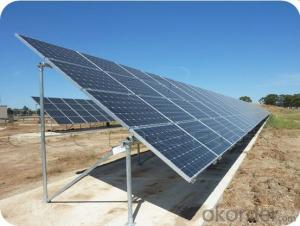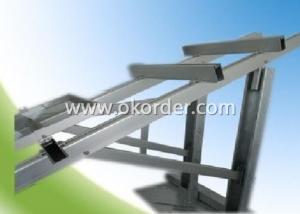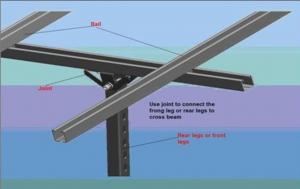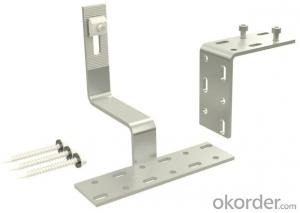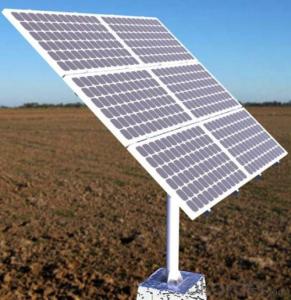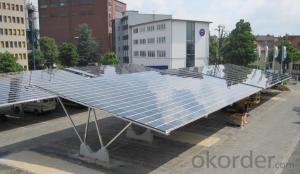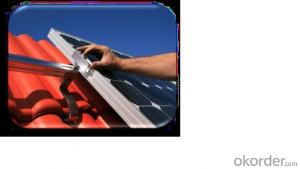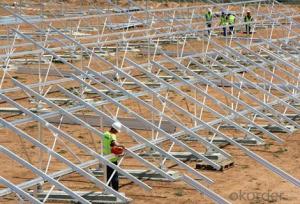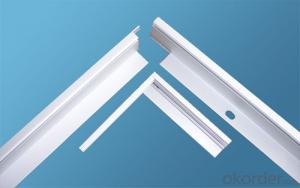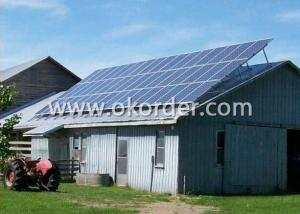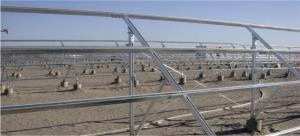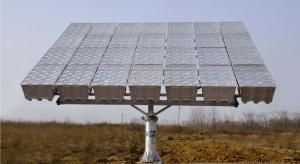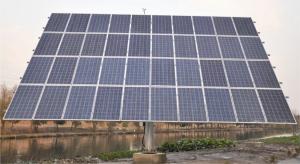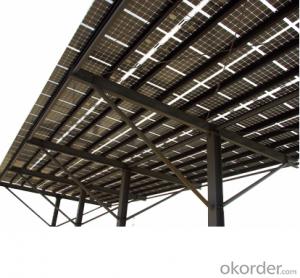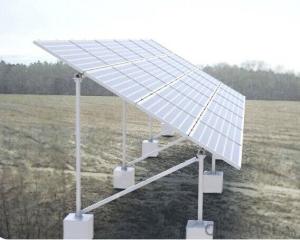Solar Panel Monting System TT-TK-S03A
- Loading Port:
- Shanghai
- Payment Terms:
- TT OR LC
- Min Order Qty:
- -
- Supply Capability:
- 50万套 set/month
OKorder Service Pledge
OKorder Financial Service
You Might Also Like
PV Mounting brackets are special solar photovoltaic systemfor placing, installing, fixing the solar panel design. Generally materials arealuminum, steel structure, stainless steel. PV mounting products at groundmounting system, flat roof mounting system, adjustable angle roof rack system,inclined roof rack system, column bracket system.
The Ground Mounting System including concret basement sysytemand steel pipe sysytem, Titanergy provides total solution for flat or pitchedroof with patent products.On the basis of the given project data, specificnational standards and guidelines, Titanergy will calculate the completestructural analysis and create a complete project plan to make sure reliablestructural safety.We provide high quality HDG steel and aluminum products forthe ground mounting sysytem,witch can make sure the security and durability ofthe project.
Features and Advantages
n The rail bracket is easy to install, just use simple tools(eg, Allen wrench) can be easily installed. Rail connecting member can freelyadjust the length, the stent may be pre-installed on the roof, and thenappropriately adjusted according to the size of the solar panel.
n The combination of strong, aluminum rails and card blocks fora variety of venues and a variety of materials roofs (such as metal, ceramicand other kinds of tile surface)
n Component compatibility, and rail can meet PV modules fromdifferent manufacturers.
n accuracy, the length of the rail to the nearest millimeter,the construction process, not because of the length is too long or too shortfor the second cut.
n flexible assembly, rail hooks can adjust the spacing modulearray and tile has been installed successfully address the uneven roofconstruction led to difficult problems.
n design standards, product design and development process instrict accordance with GB, the German standards and other internationalstandards to ensure products reach the world advanced level.
n Quality assurance, the stent main material is high-qualityaluminum and stainless steel, effectively prevent corrosion of oxidation.Products can be recycled, reducing environmental pollution.
n Carried out strictly according to the current specificnational standards
n Perfectly optimized components and complete structuralanalysis for the sysytem
n High corrosion resisitance ensure the stability and highdurability
n Total test and certification make sure the high quality ofthe products
n Maximum pre-assembled in factory,quick mounting onsite,timesaving
10-year durability warranty
Technical Data
n Design Period:25 years
n Installation Site: Open area
n Array Angle:10°~60°
n ModuleType:Framed or unframed
n Material:Q235B,Al 6063-T5,Al 6005-T5,StainlessSteel A2-70
n Coating:HDG/Anodised
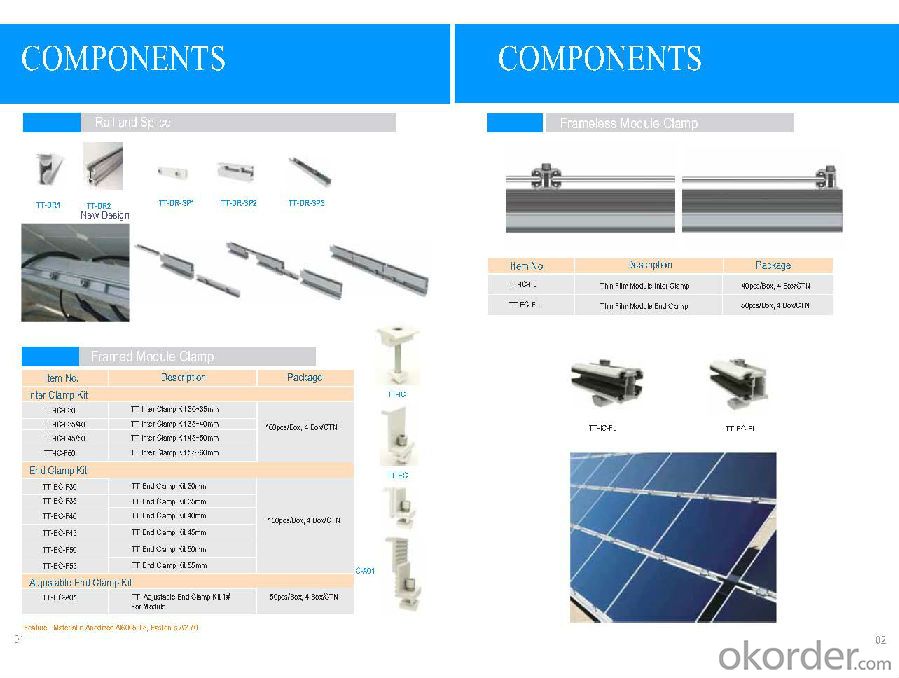

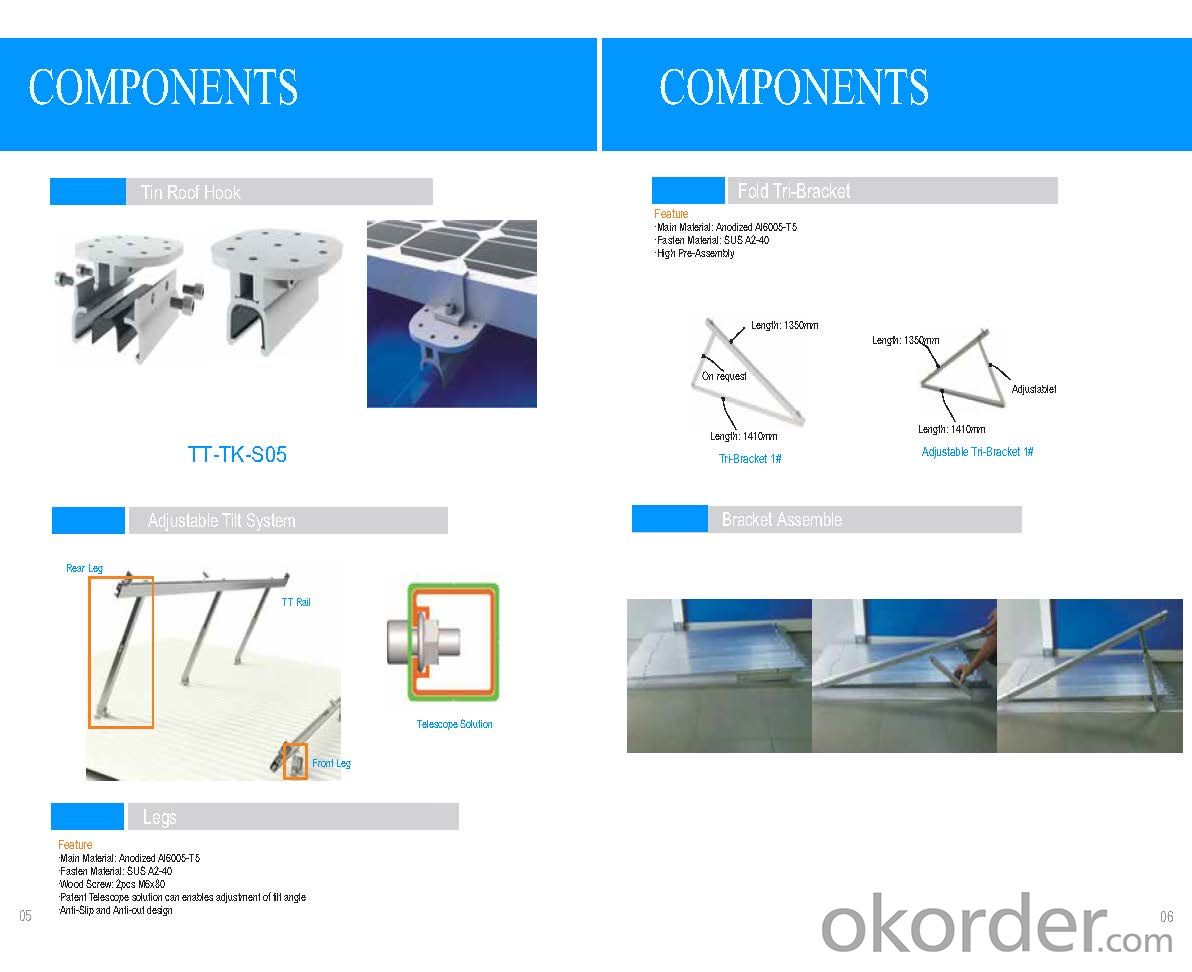
- Q:Are there any specific wind load requirements for solar mounting systems?
- Yes, there are specific wind load requirements for solar mounting systems. These requirements vary depending on the location and local building codes. The wind load requirements ensure that the solar mounting systems are designed and installed to withstand the forces exerted by high winds and gusts, providing stability and safety for the solar panels.
- Q:What are the environmental impacts of solar mounting systems?
- The environmental impacts of solar mounting systems are generally positive. These systems require the use of materials such as aluminum, steel, and concrete, which do have environmental impacts associated with their production. However, once installed, solar mounting systems have a minimal impact on the environment. They generate clean energy without emitting greenhouse gases or pollutants, thereby reducing reliance on fossil fuels and mitigating climate change. Additionally, solar mounting systems can be designed to minimize land disturbance and can even be installed on already developed areas like rooftops or parking lots, preserving natural habitats. Overall, the environmental benefits of harnessing solar energy far outweigh any initial impacts associated with the production and installation of solar mounting systems.
- Q:Are there any specific requirements for leveling when using a solar mounting system on uneven ground?
- Yes, there are specific requirements for leveling when using a solar mounting system on uneven ground. It is important to ensure that the solar panels are installed on a level surface to maximize their efficiency and performance. This may involve using leveling tools such as sandbags or adjustable legs to compensate for the unevenness of the ground. Additionally, proper alignment and positioning of the solar panels should be considered to avoid shading and optimize the sunlight exposure.
- Q:Can a solar mounting system be used in areas with solar incentives for warehouses?
- Yes, a solar mounting system can be used in areas with solar incentives for warehouses. In fact, it is highly recommended to utilize solar mounting systems in such areas as they provide a secure and efficient way to install solar panels on warehouse roofs or open spaces. These systems not only maximize the solar energy generation potential but also help warehouses take advantage of the available solar incentives and reduce their energy costs.
- Q:Are there any specific requirements for installing a solar mounting system on a mountain?
- Yes, there are specific requirements for installing a solar mounting system on a mountain. Some of these requirements include ensuring the structural stability of the mountain and the chosen location for the system, as well as the ability to withstand high winds, snow loads, and other environmental conditions specific to mountainous regions. Additionally, proper orientation and tilt angles must be considered to maximize solar energy production.
- Q:Are there any specific requirements for seismic bracing when using a solar mounting system in seismic areas?
- Yes, there are specific requirements for seismic bracing when using a solar mounting system in seismic areas. These requirements vary depending on the local building codes and regulations. Generally, seismic bracing is necessary to ensure the solar panels and mounting structure can withstand the forces generated during an earthquake. It typically involves engineering calculations, careful design of the mounting system, and the use of appropriate anchoring and reinforcement techniques. Compliance with these requirements is crucial to ensure the safety and stability of the solar installation in seismic areas.
- Q:What is the expected energy generation over the lifetime of a solar mounting system?
- The expected energy generation over the lifetime of a solar mounting system can vary depending on various factors such as the location, the type and efficiency of the solar panels, the tilt and orientation of the system, and the climatic conditions. However, on average, a well-designed and properly maintained solar mounting system can generate approximately 10 to 25 times the initial energy required to manufacture and install the system.
- Q:Can a solar mounting system be installed on a rooftop with a EPDM roof?
- Yes, a solar mounting system can be installed on a rooftop with an EPDM roof. EPDM (ethylene propylene diene monomer) roofs are known for their durability and resistance to weathering, making them suitable for solar panel installations. However, it is important to consult with a professional installer or contractor to ensure proper installation techniques and to prevent any damage to the EPDM roof during the process.
- Q:Can a solar mounting system be used in areas with solar tax-exempt financing options?
- Yes, a solar mounting system can be used in areas with solar tax-exempt financing options. These financing options are designed to promote the adoption of solar energy systems, including the infrastructure required such as mounting systems. By taking advantage of solar tax-exempt financing, organizations or individuals can finance the installation of solar mounting systems and other related components without incurring additional tax burdens.
- Q:Are there any specific requirements for solar tracker compatibility when using a solar mounting system?
- Yes, there are specific requirements for solar tracker compatibility when using a solar mounting system. The mounting system needs to be designed and engineered to accommodate the movement and weight of the solar tracker. Additionally, the mounting system should have the necessary structural integrity and flexibility to support the tracking system's functionality and movement. It is important to consult with the manufacturer or a professional to ensure that the solar mounting system is compatible with the specific solar tracker being used.
1. Manufacturer Overview |
|
|---|---|
| Location | |
| Year Established | |
| Annual Output Value | |
| Main Markets | |
| Company Certifications | |
2. Manufacturer Certificates |
|
|---|---|
| a) Certification Name | |
| Range | |
| Reference | |
| Validity Period | |
3. Manufacturer Capability |
|
|---|---|
| a)Trade Capacity | |
| Nearest Port | |
| Export Percentage | |
| No.of Employees in Trade Department | |
| Language Spoken: | |
| b)Factory Information | |
| Factory Size: | |
| No. of Production Lines | |
| Contract Manufacturing | |
| Product Price Range | |
Send your message to us
Solar Panel Monting System TT-TK-S03A
- Loading Port:
- Shanghai
- Payment Terms:
- TT OR LC
- Min Order Qty:
- -
- Supply Capability:
- 50万套 set/month
OKorder Service Pledge
OKorder Financial Service
Similar products
New products
Hot products
Hot Searches
Related keywords
